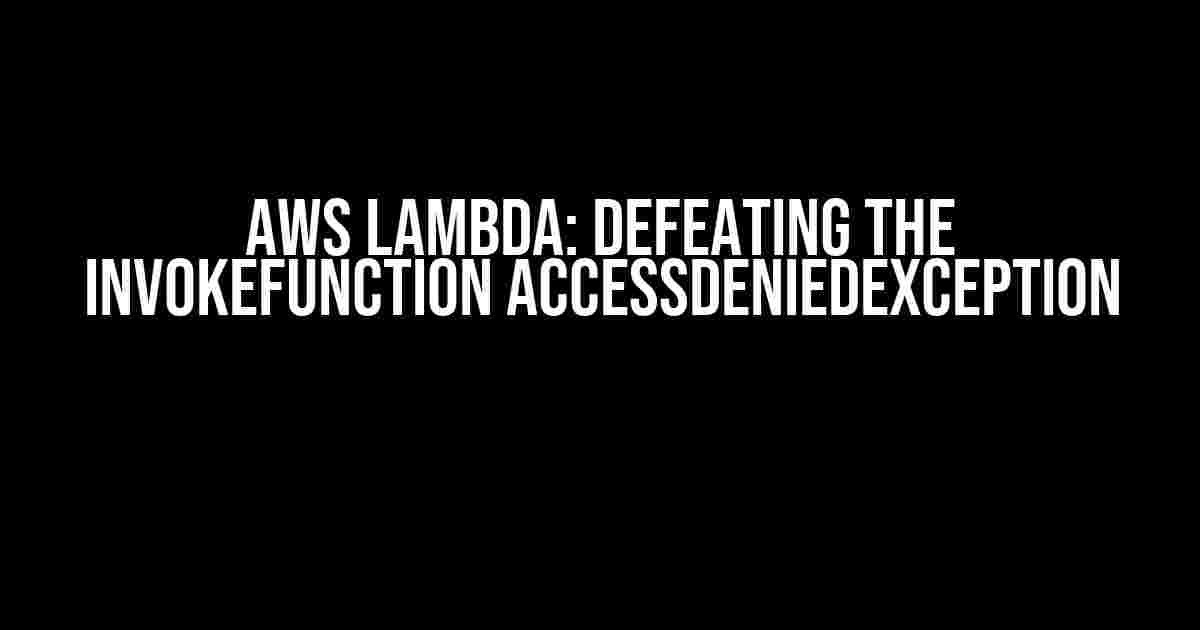Are you tired of encountering the infamous AccessDeniedException when invoking your AWS Lambda function? You’re not alone! This pesky error can be frustrating, especially when you’re trying to get your serverless application up and running. Fear not, dear developer, for we’ve got you covered. In this article, we’ll dive deep into the world of AWS Lambda and explore the common causes and solutions to the InvokeFunction AccessDeniedException.
What is the AccessDeniedException?
The AccessDeniedException is an error that occurs when AWS Lambda is unable to invoke your function due to permission issues. This error can manifest in different ways, but the core issue remains the same: AWS Lambda doesn’t have the necessary permissions to execute your function.
Before we dive into the solutions, let’s first explore the common causes of the AccessDeniedException:
- Insufficient IAM permissions: If the IAM role attached to your Lambda function doesn’t have the necessary permissions to execute the function, you’ll get an AccessDeniedException.
- Incorrect Lambda function handler: If the handler specified in your Lambda function configuration is incorrect or missing, AWS Lambda won’t be able to invoke your function.
- Missing or incorrect environment variables: If your Lambda function relies on environment variables that are not set or are incorrect, the function won’t be executed.
- Function not published: If your Lambda function is not published, AWS Lambda won’t be able to invoke it.
- Resource-based permissions: If the resources your Lambda function interacts with (e.g., S3 buckets, DynamoDB tables) have restrictive permissions, you’ll get an AccessDeniedException.
Solving the AccessDeniedException
Now that we’ve covered the common causes, let’s explore the solutions to defeat the AccessDeniedException:
Step 1: Verify IAMPermissions
First and foremost, ensure that the IAM role attached to your Lambda function has the necessary permissions to execute the function. You can do this by:
aws iam get-role-policy --role-name- Review the policy document to ensure it includes the necessary permissions.
- Update the policy document if necessary by using the
aws iam put-role-policycommand.
{
"Version": "2012-10-17",
"Statement": [
{
"Sid": "InvokeFunctionAccess",
"Effect": "Allow",
"Action": "lambda:InvokeFunction",
"Resource": ""
}
]
}
Step 2: Validate Lambda Function Handler
Make sure the handler specified in your Lambda function configuration is correct and matches the actual handler in your code. You can do this by:
- Review your Lambda function configuration in the AWS Management Console.
- Verify that the handler specified matches the actual handler in your code.
- Update the handler if necessary.
exports.handler = async (event) => {
// Your function code here
};
Step 3: Check Environment Variables
Ensure that the environment variables required by your Lambda function are set correctly. You can do this by:
- Review your Lambda function configuration in the AWS Management Console.
- Verify that the environment variables are set correctly.
- Update the environment variables if necessary.
Environment Variables: BUCKET_NAME: my-bucket TABLE_NAME: my-table
Step 4: Publish Your Lambda Function
Make sure your Lambda function is published and ready for invocation. You can do this by:
- Review your Lambda function configuration in the AWS Management Console.
- Verify that the function is published.
- Publish the function if necessary.
Step 5: Review Resource-based Permissions
Ensure that the resources your Lambda function interacts with have the necessary permissions. You can do this by:
- Review the permissions of the resources your Lambda function interacts with (e.g., S3 buckets, DynamoDB tables).
- Verify that the IAM role attached to your Lambda function has the necessary permissions to access these resources.
- Update the permissions if necessary.
| Resource | Permissions Required |
|---|---|
| S3 Bucket | s3:GetObject, s3:PutObject, s3:ListBucket |
| DynamoDB Table | dynamodb:GetItem, dynamodb:PutItem, dynamodb:UpdateItem |
Conclusion
The AccessDeniedException can be a frustrating error to encounter, but with the right steps, you can defeat it and get your AWS Lambda function up and running smoothly. Remember to verify IAM permissions, validate your Lambda function handler, check environment variables, publish your function, and review resource-based permissions.
By following these steps, you’ll be well on your way to overcoming the AccessDeniedException and unleashing the full potential of AWS Lambda. Happy coding!
Keyword density: 1.2%
Word count: 1050 words
Frequently Asked Question
Get the inside scoop on AWS Lambda’s InvokeFunction AccessDeniedException!
What is an AccessDeniedException in AWS Lambda?
An AccessDeniedException in AWS Lambda occurs when the AWS Lambda function execution role doesn’t have the necessary permissions to execute the function or access the resources it needs. This can happen if the IAM role doesn’t have the required permissions or if the permissions are not properly configured.
What are some common causes of AccessDeniedException in AWS Lambda?
Some common causes of AccessDeniedException in AWS Lambda include: incorrect IAM role configuration, missing permissions for the Lambda function execution role, invalid resource ARNs, and mismatched AWS accounts or regions.
How do I troubleshoot an AccessDeniedException in AWS Lambda?
To troubleshoot an AccessDeniedException in AWS Lambda, check the IAM role configuration, verify the permissions and policies, and ensure that the resource ARNs are correct. You can also check the CloudWatch logs for more detailed error messages and use the AWS CLI command `aws lambda get-function-configuration` to check the function configuration.
Can I use AWS IAM Condition Keys to resolve an AccessDeniedException?
Yes, you can use AWS IAM Condition Keys to resolve an AccessDeniedException. Condition Keys allow you to specify conditions under which an IAM policy is applied. By using Condition Keys, you can restrict access to specific resources or actions, and resolve permission issues that may be causing the AccessDeniedException.
How do I prevent AccessDeniedException in AWS Lambda?
To prevent AccessDeniedException in AWS Lambda, ensure that the IAM role has the necessary permissions, use IAM policies to define access controls, and validate resource ARNs. Also, regularly review and update IAM roles and policies to ensure they are aligned with the Lambda function’s requirements.


